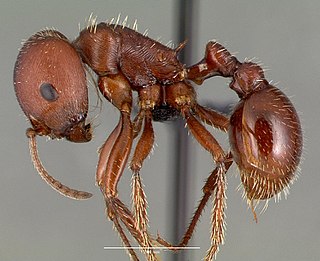
Pogonomyrmex barbatus is a species of harvester ant from the genus Pogonomyrmex. Its common names include red ant and red harvester ant. These large ants prefer arid chaparral habitats and are native to the Southwestern United States. Nests are made underground in exposed areas. Their diets consist primarily of seeds, and they consequently participate in myrmecochory, an ant-plant interaction through which the ants gain nutrients and the plants benefit through seed dispersal. Red harvester ants are often mistaken for fire ants, but are not closely related to any fire ant species, native or introduced.

Pogonomyrmex is a genus of harvester ants, occurring primarily in the deserts of North, Central, and South America, with a single endemic species from Haiti.

Harvester ant, is a common name for any of the species or genera of ants that collect seeds, or mushrooms as in the case of Euprenolepis procera, which are stored in the nest in communal chambers called granaries. They are also referred to as agricultural ants. Seed harvesting by some desert ants is an adaptation to the lack of typical ant resources such as prey or honeydew from hemipterans. Harvester ants increase seed dispersal and protection, and provide nutrients that increase seedling survival of the desert plants. In addition, ants provide soil aeration through the creation of galleries and chambers, mix deep and upper layers of soil, and incorporate organic refuse into the soil.

A queen ant is an adult, reproducing female ant in an ant colony; she is usually the mother of all the other ants in that colony. Some female ants, such as the Cataglyphis, do not need to mate to produce offspring, reproducing through asexual parthenogenesis or cloning, and all of those offspring will be female. Others, like those in the genus Crematogaster, mate in a nuptial flight. Queen offspring ants among most species develop from larvae specially fed in order to become sexually mature.

Pogonomyrmex maricopa, the Maricopa harvester ant, is one of the most common species of harvester ant found in the U.S. state of Arizona, but it is also known from California, Colorado, New Mexico, Nevada, Texas and Utah, and the Mexican states of Baja California, Chihuahua, Sinaloa and Sonora. Its venom is believed to be the most toxic insect venom in the world.

Pogonomyrmex californicus, or California harvester ant, is a species of ant in the subfamily Myrmicinae. It is native to North America, where it occurs in the southwestern United States and northern Mexico. It is best known as the ant that is sent out for Uncle Milton's Ant Farm.

Pogonomyrmex occidentalis, or the western harvester ant, is a species of ant that inhabits the deserts and arid grasslands of the American West at or below 6,300 feet (1,900 m). Like other harvester ants in the genus Pogonomyrmex, it is so called because of its habit of collecting edible seeds and other food items. The specific epithet "occidentalis", meaning "of the west", refers to the fact that it is characteristic of the interior of the Western United States; its mounds of gravel, surrounded by areas denuded of plant life, are a conspicuous feature of rangeland. When numerous, they may cause such loss of grazing plants and seeds, as to constitute both a severe ecological and economic burden. They have a painful and venomous sting.

Pogonomyrmex rugosus, the desert harvester ant or rough harvester ant, is a species of harvester ant in the subfamily Myrmicinae which is endemic to the southwestern United States, specifically New Mexico and southern Colorado.
Pogonomyrmex fossilis is an extinct ant species which lived during the Eocene 34 million years ago. The species built nests primarily destined to store seeds and grains as winter stock. The ant has an average length of six millimeter and an average width of 1.2 millimeters.

Pogonomyrmex badius, or the Florida harvester ant, is a species of harvester ant in the genus Pogonomyrmex. It is the only Pogonomyrmex species found on the east coast of the United States and the only one in North America known to be polymorphic. The Florida Harvester ant is commonly found in Florida scrub and other similar habitats within the Atlantic coastal plain states.

Pogonomyrmex subdentatus is a species of ant in the family Formicidae.

Pogonomyrmex bigbendensis is a species of ant in the family Formicidae.

Pogonomyrmex anzensis, the Anza desert harvester, is a species of ant in the family Formicidae.

Pogonomyrmex comanche, the Comanche harvester ant, is a species of ant in the family Formicidae.

Pogonomyrmex salinus is a species of ant in the family Formicidae.

Pogonomyrmex bicolor, the bicolored harvester ant, is a species of ant in the family Formicidae.

Pogonomyrmex imberbiculus is a species of ant in the family Formicidae.

Pogonomyrmex apache is a species of ant in the family Formicidae.

Pogonomyrmex desertorum, the large seed harvesting ant, is a species of ant in the family Formicidae.



















